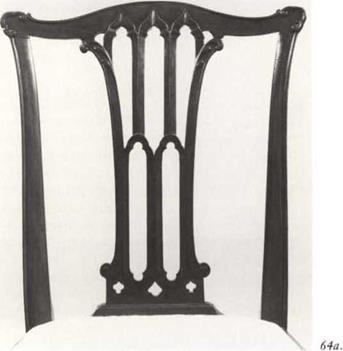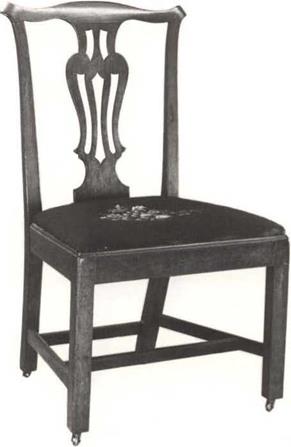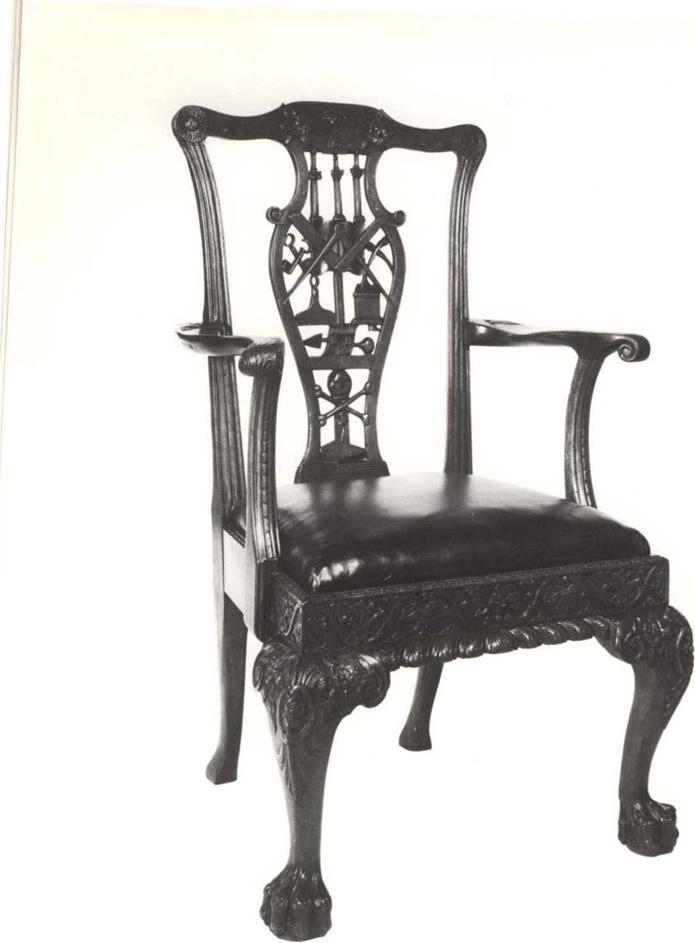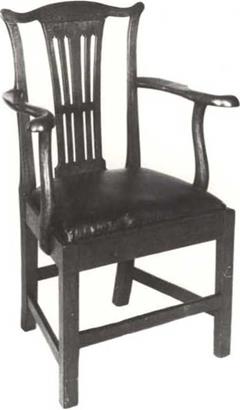Kdmund Dickinson operated the Hay shop from 1771 until 1776, and if written documentation is any indication, he ran a very successful business. Unfortunately, no indisputably documented furniture by him is known, and again a group of furniture is attributed to the 1 lay shop on circumstantial evidence. Only in one instance can Dickinson possibly be associated with furniture that corresponds to a written document: a tea table (fig. 57) reputedly sold from the Governor’s Palace in the eighteenth century, and a chair with a history indicating that it was among the property abandoned by Lord Dunmorc and sold in 1776. This chair was purchased by a member of the Galt family of Williamsburg who continued to own it until it w as acquired recently by the Colonial Williamsburg Foundation. In addition, it was among the few colonial furnishings shown in Norfolk’s Art Loan Exhibition of 187V, which is the earliest documentation of its Dunmore-Palace tradition. fie The chair may be associated with Dickinson on the basis of Dunmore’s £30 account w ith him (see footnote 46).
Attribution of the tea table to the 1 lay shop depends principally on the use of the trumpet foot (fig. 57), which corresponds to an unfinished leg excavated at the 1 lay site in the context of objects dating from 1765-75 (fig. 65). The top of this table was originally attached to the base by a series of small, evenly spaced blocks, a method similar to the two side tables attributed to the Bucktrout period of the 1 lay shop (figs. 54, 55).
Another feature associated w ith the I lay shop is the method of forming the top by gluing a molding into the rabbeted edge, although in this example the added pieces have long since disappeared (fig. 57a). The indented corners are another Williamsburg feature, and each was originally fitted w ith two small sections of raised molding, mitered at the corner and butted against the longer portions of the side. This method of construction is remarkably similar to the indented corners of door panels in the Scott group (tig. 36b) and the Williamsburg case-piece group (fig. 77b).
The “Dunmorc” chair (fig. 58) is made of w alnut with a yellow pine and oak slip scat; it retains the original black leather upholstery beneath a later covering. The upholstery technique is consistent w ith that of the Scott group and another example excavated at the 1 lay shop (fig. 67). It has an integral rear seat rail and shoe, and although this feature is also consistent w ith the Scott group, there is a departure: the bottom edge of the rear rail is straight without the usual horizontal shaping. Other variations from the Scott type are the stiles that flare outward, thereby creating a wider crest rail and a narrower stance to the rear legs. While this chair shows some association w ith those of the Scott group, it also introduces variations, and its relationship to Edmund Dickinson cannot be established until another piece that repeats these variations is examined.
|
58. Side Chair, attributed to the Anthony Hay Shop, probably Edmund Dickinson, circa 1771-75. Walnut primary; oak and yellow pine slip seat with original black leather upholstery beneath later covering. Height 36 V»", width 21", depth 17 W. The Colonial Williamsburg Foundation (acc. no. 1978-10). |
|
|
Displaying some of the finest carving from eastern Virginia, the Master’s chair from Masonic Lodge Four in Fredericksburg is the fourth example of ceremonial chair production from the Hay shop (fig. 59).67 The modified concepts of the Scott group seen in the preceding chair are repeated in this example. Other Scott construction is also present: the arms are dovetailed into the stiles; the knee brackets overlap the seat rail; the gadroon is glued to the front of the seat rail;68 and the rear legs are contoured to end in a shaped foot. The flaring back, straight rear rail, and the carving, however, differ from that of the Scott group.

 To understand the combination of details seen on this chair, one must again study the excavated easy chair leg from the 1 lay shop (fig. 65). This leg has two features that relate it closely to the Lodge Four chair (figs. 59, 70). First, its long mortises are the Scott type which utilizes a deep seat rail with wide tenons. This arrangement causes the knee brackets to overlap the seat rails. Second, the sharp corner on the leg is carried dow n the front of the cabriole and is so prominent that a fairly angular finished product is indicated. This is particularly noticeable near the foot, where insufficient wood remains to produce a rounded ankle of the usual type. This relates to the legs of the Lodge Four chair, which have an acute angle down the front to sueh a degree that the carving is divided into two planes (fig. 70). The relationship between them is very convincing, particularly in light of a major emphasis in the Williamsburg school on rounded legs and rounded corners.
To understand the combination of details seen on this chair, one must again study the excavated easy chair leg from the 1 lay shop (fig. 65). This leg has two features that relate it closely to the Lodge Four chair (figs. 59, 70). First, its long mortises are the Scott type which utilizes a deep seat rail with wide tenons. This arrangement causes the knee brackets to overlap the seat rails. Second, the sharp corner on the leg is carried dow n the front of the cabriole and is so prominent that a fairly angular finished product is indicated. This is particularly noticeable near the foot, where insufficient wood remains to produce a rounded ankle of the usual type. This relates to the legs of the Lodge Four chair, which have an acute angle down the front to sueh a degree that the carving is divided into two planes (fig. 70). The relationship between them is very convincing, particularly in light of a major emphasis in the Williamsburg school on rounded legs and rounded corners.
Many other reasons exist to support the attribution of this chair to the I lay shop. One of the most important is the inclusion of animal feet, which arc – rare in America, the only other Virginia examples being clearly associated with this shop. The superb lion’s feet of the Capitol chair, the smooth paw of the Lodge Six chair, and the dolphin’s feet of the Buektrout chair are all attributed to the I lay shop masters. One further example, an unfinished table – leg from the 1 lay site, certainly appears to have been intended as an animal foot (fig. 66) and gives solidarity to the attribution of these feet to the I lay shop.
Several important features of the Lodge Four ehair link it closely to the Lodge Six chair, and to other I lay shop production as well. The cabriole leg and nearly vertical toes are remarkably similar to the legs and feet of the Lodge Six example (figs. 47, 72). The arm terminal (fig. 59a) features an acanthus that is contained within a relief border that follows the outline of the arm. This arm carving is a modified version of the arm support on the Capitol and Lodge
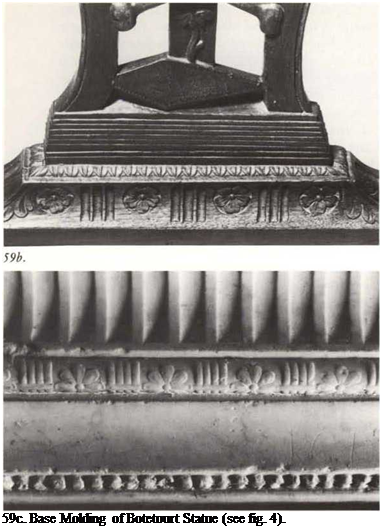
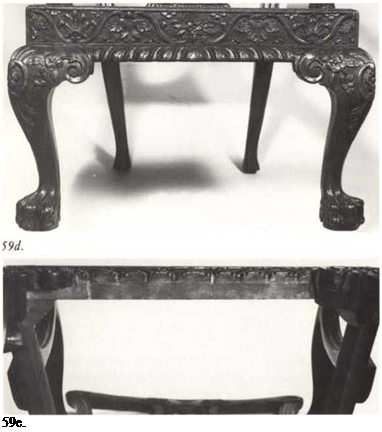
Six chairs (figs. 46b, 47c), on which the acanthus is also confined within a border. The punched background in some areas of the carving is another technique linking these chairs. In each example two different types of punch were used: the majority was done w ith a sharp-pointed tool, while in other areas a tool with a small circular point was employed. The Lodge Four chair uses circular marks to simulate nail heads on the edges of the coffin depicted at the bottom of its splat (fig. 59b), while the Lodge Six has such marks on the area behind the coat of arms, thistle, and rose (fig. 47b).
Certain carved designs on this chair appear to have been inspired by Chippendale’s Director. The naturalistic stems with flowers and leaves that issue from the volutes on the knees (figs. 59d, 70) are strikingly similar to those on the center chair of plate X. This Director-inspired foliage was abbreviated to accommodate the opposing C-scrolls that form the basis of the central knee carving. This design was also adapted to the knee bracket on a Scott chair (fig. 20). The same Chippendale plate also appears to have influenced the shoe carving (fig. 59b), but instead of the continuous vertical flutes shown in the Director, the carver interspersed four flowers. ea
Although overwhelmingly rococo, the carving on the Lodge Four chair does have several departures from this style. The center of the arm supports has a running husk design typical of neo-classic taste. An example of this design is found on the Buzaglo stove, ordered from London for the Capitol and delivered to Williamsburg in 1770 (fig. 3). Two other details, both of them carved moldings, are indisputably neo-classic (fig. 59b). On top of the shoe is a row of flat leaves, each with a simple vein in its center; below these is a repeat carv ing of three vertical flutes alternating with incised circles, containing five – petalied rosettes (fig. 59b). The location of this carving appears to have been inspired by the central chair in plate X of Chippendale’s Director, although the design of this example is neo-classic. A virtually identical carved border appears on the top of an Fnglish commode, ca. 1772, w hich is attributed to John Cobb, upholsterer to George III.7" A variation of the same design is found on a base molding of the statue of Lord Botetourt, w hich w as ordered from sculptor Richard Hayward of London in 1771 and arrived in Williamsburg during June < >f 1773 (figs. 4, 59c).
A summation of the findings regarding this chair show it to be a product of the Williamsburg school, w ith a revealing combination of features:
—The construction is tied to that of the Scott
group.
— The style is definitely related to 1 lay shop products and is firmly linked to excavated material from that site.
—While portions of the design are related to earlier 1 lay shop examples, the carving is quite different from that of Hay, Bucktrout, or Scott, and indicates the work of a different artisan.
—It has details taken front Chippendale’s Director.
—It incorporates several elements of neo-classic design.
W ith the 1 lay shop established as the origin of the Lodge Four chair, the Palace chair (fig. 58) associated with it may be more firmly linked to the Dickinson account with Dunmore. The Governor’s presence in Virginia between 1771 and 1775 provides a bracket date for the chair and also corresponds to Dickinson’s operation of the shop. Further corroborating this time bracket are the neo-classic details, which represent developments of the early 1770s.
Attribution of these chairs to Dickinson thus established, it is possible to examine other aspects of the Lodge Four chair. Its relationship to Chippendale’s Director is not unexpected since Dickinson owned a copy of that book. The high quality of both the design and the execution are directly related to London taste, confirming the work to be that of a professional carver with a sound know ledge of urban style. The flowers and leaves are well sculptured and have a character often seen on rococo looking glasses. The gadroon w ith the overlapping acanthus, frequently seen on English chairs, is the only such work known in America. This carving, which differs from earlier I lay shop production and incorporates neoclassic detail, is explained by the presence in Dickinson’s shop of George Hamilton, the professional carver and gilder from Scotland. I lis advertisement mentioning the “Palmyrian taste” is concrete proof that he worked in the neo-classical style and is one of the earliest such references of its kind in America.
This combined evidence indicates that this chair is the product of Dickinson and 1 iamilton, and it can be considered among the earliest furniture produced in America to show an impact of the neo-classical style. Interestingly, oral tradition states that this chair was given to the Fredericksburg Lodge by the Grand Lodge of Scotland—a claim that is incorrect unless the Grand Lodge commissioned it to be made in America. It is possible, however, that I lamilton’s Scottish origin was the cause of this belief.
All the pieces in the I lay group dating before the signed Bucktrout chair have knee brackets nailed and glued, or just glued, to the underside of the rails. Oddly enough, the signed Bucktrout chair is the Scott type in this respect. This holds true for the easy chair leg excavated at the I lay shop, as w ell as for the Dickinson Lodge Four chair. Such a mixture of construction undoubtedly resulted from the frequent use of journeymen, for whom pay-by-the – month, or pay-by-the-piece allowed a great deal of latitude. A journeyman trained in the Scott approach might produce this type in a shop that had previously employed other methods of construction.
 There are two other Williamsburg chairs in the Fredericksburg Masonic I»dge. The Senior W arden’s chair (fig. 60), obviously made en suite w ith the Master’s, has a splat that is essentially the same, although considerably weaker in execution. The stiles appear to be very old replacements, and are rougher in workmanship than the rest of the elements. They also have an unusually straight angle from the seat to the floor. This piece, like its more sophisticated mate, may be considered a product of Dickinson’s shop. A third chair ow ned by the Lodge (fig. 61) is very simple and also show s peculiarities of Scott construction. Its rear seat rail is numbered “XIII, indicating the original existence of a large set. The set may have been made for Lodge use, or perhaps it w as originally intended for a household and then brought to the Lodge.
There are two other Williamsburg chairs in the Fredericksburg Masonic I»dge. The Senior W arden’s chair (fig. 60), obviously made en suite w ith the Master’s, has a splat that is essentially the same, although considerably weaker in execution. The stiles appear to be very old replacements, and are rougher in workmanship than the rest of the elements. They also have an unusually straight angle from the seat to the floor. This piece, like its more sophisticated mate, may be considered a product of Dickinson’s shop. A third chair ow ned by the Lodge (fig. 61) is very simple and also show s peculiarities of Scott construction. Its rear seat rail is numbered “XIII, indicating the original existence of a large set. The set may have been made for Lodge use, or perhaps it w as originally intended for a household and then brought to the Lodge.
|
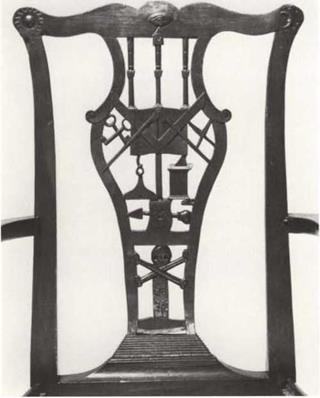
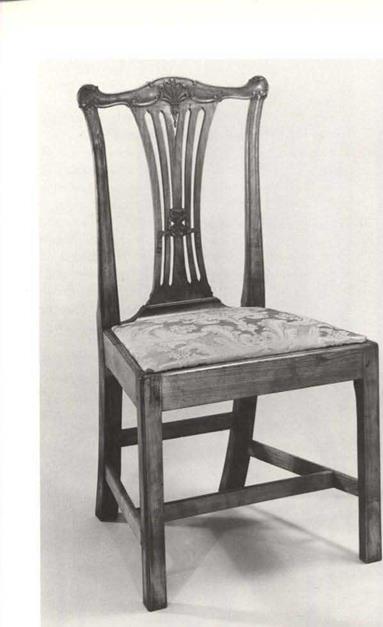
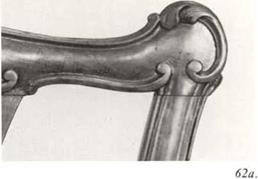 |
62. Side Chair, attributed to the Anthony Hay Shop, probably Edmund Dickinson with carving by George Hamilton, Williamsburg, circa 1775.
Cherry primary; oak slip seat.
Height 38V»",’width 21", depth 20".
The Colonial Williamsburg Foundation (acc. no. 1965-184).
One of the finest side chairs produced in Williamsburg descended in the Benjamin Waller family there (fig. 62). Made of cherry, it has carving with a crispness of quality equal to that of the Lodge Four chair. The crest rails arc also quite similar, with three C-scrolls across the top and large ears at the sides. These rails are stylistic variations of a Scott type (fig. 27). The molded stiles are also related and both share Scott group construction as well. The Waller chair’s rear seat rail is not straight, however, but has horizontal shaping identical to the Scott group.
Two elements of the carving in this piece are of special interest. The low er center of the splat has a
tied ribbon (fig. 62d) that is virtually identical to one shown on the left chair in plate XV of Chippendale’s Director (fig. 62c). Above this ribbon, in the center of the crest, is a well-carved anthemion (fig. 62b). 1 lere the design, like that of the Lodge Four chair, combines details from the Director and early neoclassic elements. The anthemion, with husk and pendant, is remarkably similar to the one on the Buzaglo stove (fig. 62c)—enough so, in fact, to suggest it as a possible source for the design. This is emphasized by the fact that other anthemia found on the stove and on the Botetourt statue lack the husk and pendant detail.
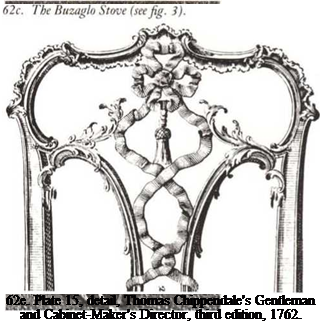 |
 |
The carving of this chair is further related to other pieces in the I lay group. Stippling or punch work is found within the carved ribbon and, likewise, on the inside areas of the anthemion. T his is precisely the practice seen on the knee carving of the Lodge Four chair (fig. 70) and repeated on its scat rails. It is also utilized on the Lodge Six chair back (fig. 47b) and on the capitals of the Bucktrout chair (fig. 49b). Certainly stippling w as used elsewhere in this manner, but examples from New F. ngland and Philadelphia usually show the use of punch work outside the area encompassed by the carving. Considering the scarcity of carved Virginia furniture and the localized provenance of these pieces, this restricted use is significant.
The (.-scrolls of the ears on the Waller chair (fig. 62a) end with a heavily lobed acanthus that curls from the back of the scroll. This is also seen on the Lodge Four chair, w here it is most obvious in the large acanthus on the front of the knee (fig. 70). The С-scrolls, like the acanthus, are also similar, with a cove on the inside surface and a slightly convex surface on the back. In contrast the scrolls of the Bucktrout and Lodge Six chairs are quite different, since their backs are not contoured and stand out harshly. Another feature common to the Lodge Four and W aller chairs is the practice of shading, achieved by using a small gouge to cut small parallel lines at right angles to the main direction of the ornament.
I his can be seen on the petals of the flowers of the
Lodge Four chair (fig. 59d) and in numerous places on the ribbon of the Waller chair (fig. 62d).
Another example is a high post bed with Marlboro legs and molded block feet that descended in the Galt family of Williamsburg (fig. 63). Although the carving on its foot posts is somew hat coarser than that of the preceding chairs, it is related to them. A strikingly similar bed illustrated in The Magazine Antiques has carving w ith wheat grain, flat palm leaves, and reeds that simulate clustered columns on its top section—features that are found in a simplified version on the Galt bed.71 It also has w heat sheaves held by a tied ribbon that is very closely related to the ribbon on the Waller chair. The execution of these ribbons and of the grains of wheat of the beds are so nearly identical that their origin appears to be the same—in all probability the I lay shop during Dickinson’s period there.
63. Beil, detail, attributed to the Anthony Hay Shop, Williamsburg, circa 1773.
Mahogany primary; poplar secondary.
Post size: height 84 W, width З V»", depth 3’A".


The Colonial Williamsburg Foundation (acc. no. 1978-14).
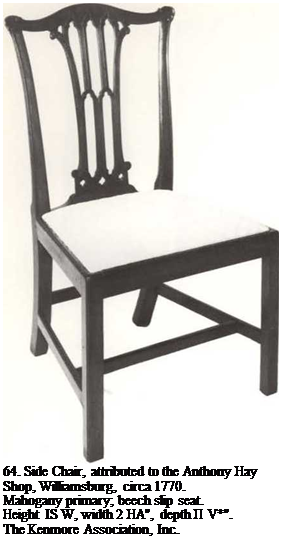 Two side chairs at Kenmore in Fredericksburg can also be tentatively attributed to the Dickinson period (fig. 64). They have an integral shoe and a rear seat rail that is straight in profile—a feature consistent with the Palace and the Lodge Four chairs (figs. 58, 59). The simple crest rail can be seen on several other Williamsburg pieces, and molded stiles also occur on the Lodge Four and Waller chairs (fig. 62), although all three moldings are different. The splat has chip carving around the piercing in its base —a technique used extensively on the Capitol and Lodge Six arm supports (figs. 46c, 47d). The beaded edge and the small volute on the splat of the Kenmore chairs arc related to those on the Lodge Four chair. Only the narrow seat rails of this piece differ from most others of local origin, and they alone constitute the greatest doubt for an attribution to Dickinson. I low ever, they are also found on a chair originally at Blandficld, that has a simple ribbon in its splat and that appears to be related to figure 62.72
Two side chairs at Kenmore in Fredericksburg can also be tentatively attributed to the Dickinson period (fig. 64). They have an integral shoe and a rear seat rail that is straight in profile—a feature consistent with the Palace and the Lodge Four chairs (figs. 58, 59). The simple crest rail can be seen on several other Williamsburg pieces, and molded stiles also occur on the Lodge Four and Waller chairs (fig. 62), although all three moldings are different. The splat has chip carving around the piercing in its base —a technique used extensively on the Capitol and Lodge Six arm supports (figs. 46c, 47d). The beaded edge and the small volute on the splat of the Kenmore chairs arc related to those on the Lodge Four chair. Only the narrow seat rails of this piece differ from most others of local origin, and they alone constitute the greatest doubt for an attribution to Dickinson. I low ever, they are also found on a chair originally at Blandficld, that has a simple ribbon in its splat and that appears to be related to figure 62.72
The twenty-one pieces of furniture that have been studied closely in this section share many interrelated constructional and stylistic features. Of the Williamsburg group that follow s, some contain pieces with evidence that suggest they, too, may be from the 1 lay shop. These will be clearly pointed out, and the evidence they present will be discussed in corresponding portions of the text. Before proceeding to these groups, however, discussion of a number of objects excavated from the I lay site w ill help shed further light on the cabinetmaking trade in early Williamsburg.
|
